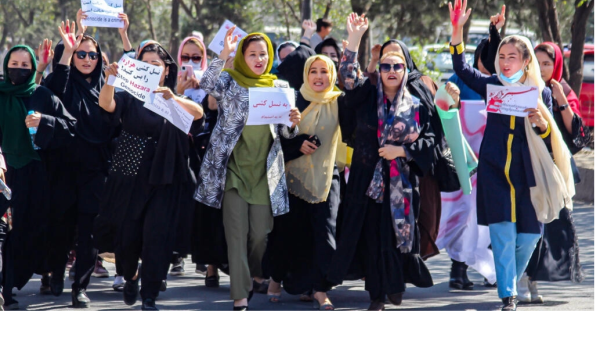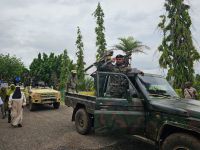Contributed by George Kerr
On the 31st of September, 35 girls and young Hazara women were killed and over 82 injured by a suicide bomb attack in the Kaaj Educational Center in the Dasht-e-Barchi district of West Kabul, Afghanistan. It is believed that Islamic State-Khorasan (IS-K) is responsible for the attack, targeted against teenagers receiving tutoring for a university exam. Widespread anti-Taliban protests have followed, with women in Herat, Bamiyan, Balkh, Panjshir, Balghan and Jalalabad taking to the streets. The Taliban have suppressed these expressions of civil solidarity with brutality and detainment. Whilst this dissent is somewhat unprecedented, persecution of the Hazaras in Afghanistan is anything but.
The Hazaras have faced targeted persecution in Afghanistan for over a century. However, with the withdrawal of American troops, whose presence granted Hazaras unprecedented freedoms and advancements, the Hazaras’ only protectors are the Taliban– a group who systematically displaced, exiled and massacred Hazaras in the thousands during their rule in the 1990s– most notably the 2,000 in three days in Mazar-i Sharif in 1998.
Very important! Remmber it is for your own future, and for the millions of Hazaras that are kept as prisoners in Afghanistan!#StopHazaraGenocide pic.twitter.com/4rfjTPyC0S
— Hazara Voice (@HazaraVoicee) November 8, 2022
The Taliban’s belief in Pashtun supremacy in Afghanistan and their disdain for practitioners of Shi’a Islam, whom they consider apostates, places Hazaras at critical risk of future ethnically motivated mass killings. The Taliban famously have a saying: ‘Tajiks to Tajikistan, Uzbeks to Uzbekistan, and Hazaras to goristan’ (cemetery in Pashto). This attitude has prevailed under the new Taliban government, despite the claims of their political wing in Jalalabad that they have become a more moderate, measured group than they were in the 1990s.
Human rights organisations have recorded a plethora of war crimes committed against Hazaras during the Taliban surge to power in 2021, despite their subsequent claims that they would protect ethnic minorities. Amnesty International has produced reports confirming the massacre of nine ethnic Hazara men in the Ghazni province in July 2021, 13 ethnic Hazaras in Daykundi province in August 2021 and most recently, on September 15th, the torture and execution of Hazaras in Ghor province, including a 12-year-old girl. Human Rights Watch has documented the forced eviction of hundreds of Hazara families from the southern Helmand province and the northern Balkh province in October 2021; Hazara property was then given to Taliban supporters as a reward. Forced evictions are prohibited under international law.
Ms. Cassandra Fernando, an Australian Parliament Member, raised the Hazaras concern in the Australian Federal Parliament.
We hope that the Hazara's voices are heard and the Australian Parliament formally recognize the genocide of our people in Afghanistan.#StopHazaraGenocide pic.twitter.com/QIsblCIAVo
— General Murad (@GeneralMurad4) November 7, 2022
To make matters worse for the Hazaras, the Taliban are facing their own insurgency from IS-K, a group that considers Shi’a Muslims infidels who should be exterminated. Though the Taliban have staked their legitimacy on their ability to bring stability to the country– which has been torn apart by multiple conflicts since the 1970s– IS-K have carried out a number of attacks in the last year, many of which have targeted Hazaras.
The school bombing which targeted the Hazara community in Dasht-e-Barchi, Kabul, in April 2022, killing six people and injuring eleven, and the aforementioned September 2022 bombing in the same district highlights the Taliban’s failure as a peace keeping force. As Samira Hamidi, Amnesty International’s South Asia Campaigner said:
“It [...] shows that the Taliban, as the de-facto authorities, are failing to protect civilians, especially those from ethnic and religious minority groups, from harm”
The Taliban also failed to prevent other targeted attacks on Hazara, Shi’a communities, such as IS-K’s suicide bomb attack on a Hazara mosque in the Northern city of Kunduz in October 2021. These failures have weakened the Taliban’s assertion that they could provide more protection to civilians than the previous government: President Ashraf Ghani was criticised for failing to secure the Hazara area of Dasthe Barchi, where a school was bombed in May, killing 90 and injuring 240.
Az a Hazara girl I wanna to say;
Hazaras are the most civilised , peaceful and education lovers of Afghanistan. during the history of Afghanistan, Hazaras haven´t harmed a single human being. @UN Be our voice and recognize this genocide.#StopHazaraGenocide pic.twitter.com/6XvBLJGFOc
— Mahdia Najwa (@mahdia_najwa) November 6, 2022
Historical treatment of the Hazaras in Afghanistan
Hazaras have long faced oppression in Afghanistan and have been excluded from political rights given to other ethnic groups. Ethnically different from the Pashtun majority– with Turkic heritage and easily identifiable Mongoloid features, the Hazaras have long been persecuted by Pashtun leaders. Since the Pashtun King Amir Abdul Rahman declared a jihad against them in the late 19th century– owing to their Shi’a faith– Hazaras have been summarily killed, forced into exile or slavery, and had their land confiscated and redistributed amongst Pashtun ‘Kuchis’, who were permitted by royal decree to forcefully confiscate Hazaras’ land and livestock. Until the 1970s, Afghan law barred Hazaras from enrolling in university or holding public office.
Hazaras have also been economically marginalised by successive governments in Afghanistan. The Hazara majority Hazarajat region in central Afghanistan has been consistently deprived of the billions of dollars in aid that has been poured into Afghanistan since 2001. Today, it is one of the poorest regions in Afghanistan.
The Hazaras are socially progressive in the Afghan context; they have a tradition of educating their young women, and the governor of the province of Daykundi in Hazarajat was a woman– Shaima Rostamyan– in February 2021. Within Daykundi, there was an annual women’s bike race from 2018 to support women in sport.
However, since the Taliban seized power, Hazara politicians have been exiled, and the governor was replaced by Aminullah Zubair: a male, Taliban politician. The socially progressive attitudes of the Hazaras increase the enmity of Sunni extremists towards them. The Taliban, who themselves have already curbed the rights of women to go to school and to work, are unfit to be the guardians of the Hazaras against terrorist attacks.
The dangers of IS-K’s insurgency: a worse alternative?
With the Taliban failing to deliver on their promise to bring stability to Afghanistan, some fear, such as Hashmat Moslih, that the population will begin to look to IS-K as a more effective alternative. IS-K’s fiercely genocidal attitude towards Shi’a Muslims– stemming from a combination of Salafist ideology and the mistreatment of Sunnis by the repressive, minority-Shia governments in Iraq and Syria– would spell doom for the Hazaras if a caliphate were to be formed.
Failures of leadership by the Taliban would fuel the IS-K argument that the Afghan nation state is not working, and that a borderless, Islamic caliphate should replace it. If public opinion sways towards IS-K as a result of the Taliban’s weakness– as people became disillusioned with the previous Afghan government– the Hazaras could find themselves at an even higher risk of mass killings.
What should be done?
Awareness of the Hazaras’ plight is steadily increasing, with #StopHazaraGenocide appearing on social media. However, there have been instances of the Taliban attempting to prevent journalists from stating that the victims of attacks were Hazaras, and to be referred to as ‘Afghans’. This has resulted in reports of atrocities committed against Hazaras as against ‘Shiites’, ‘Shias’ and occasionally ‘Afghans’.
This reduces awareness of the deliberate, targeted nature of the attacks based on ethnic lines. Ethnicity encompasses shared racial, cultural, and linguistic heritages as well as religious, and thus, what is happening to the Hazaras in Afghanistan goes beyond sectarianism: it could foreshadow full-scale ethnic cleansing. It is the duty of reporters to specify, when they are, that it is Hazara communities being attacked.
The #Hazara nation, living mostly in Central of Afghanistan,faced the worst genocide at the hands of Afghan Cruel Rulers and Terrorist Groups.thousands of Hazaras were massacred,sold out as slaves to neighboring countries,and forced to migrate to Central Asia. #StopHazaraGenocide pic.twitter.com/Yht4KElvFY
— PMZ Ahmadi (@PMZAhmadi) November 8, 2022
Without the specificity regarding the intent of such killings, and international recognition of the ethnic character of the violence, the response of the international community could lack the proportionality it requires, and Hazaras could face further mass killings.
The views expressed in this article do not necessarily reflect those of Al Bawaba News.







